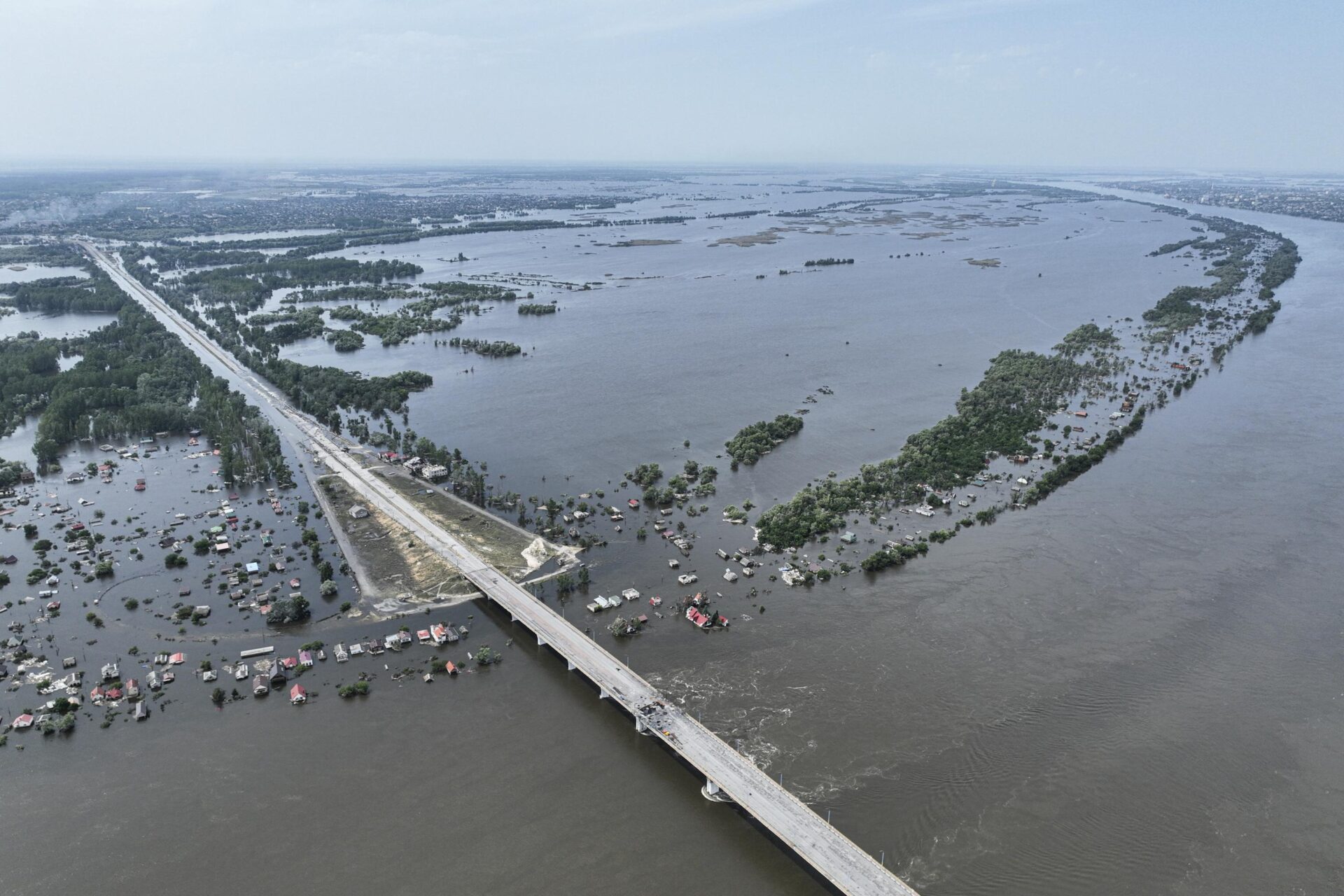Top News: US & International Top News Stories Today | AP News
Houses are seen underwater in the flooded village near Kherson, Ukraine, Saturday, June 10, 2023. The destruction of the Kakhovka Dam in southern Ukraine is swiftly evolving into long-term environmental catastrophe. It affects drinking water, food supplies and ecosystems reaching into the Black Sea. (AP Photo)
KHERSON, Ukraine (AP) — The destruction of the Kakhovka Dam was a fast-moving disaster that is swiftly evolving into a long-term environmental catastrophe affecting drinking water, food supplies and ecosystems reaching into the Black Sea.
The short-term dangers can be seen from outer space — tens of thousands of parcels of land flooded, and more to come. Experts say the long-term consequences will be generational.
For every flooded home and farm, there are fields upon fields of newly planted grains, fruits and vegetables whose irrigation canals are drying up. Thousands of fish were left gasping on mud flats. Fledgling water birds lost their nests and their food sources. Countless trees and plants were drowned.
If water is life, then the draining of the Kakhovka reservoir creates an uncertain future for the region of southern Ukraine that was an arid plain until the damming of the Dnieper River 70 years ago. The Kakhovka Dam was the last in a system of six Soviet-era dams on the river, which flows from Belarus to the Black Sea.
Then the Dnieper became part of the front line after Russia’s invasion last year.
“All this territory formed its own particular ecosystem, with the reservoir included,” said Kateryna Filiuta, an expert in protected habitats for the Ukraine Nature Conservation Group.
THE SHORT TERM
Ihor Medunov is very much part of that ecosystem. His work as a hunting and fishing guide effectively ended with the start of the war, but he stayed on his little island compound with his four dogs because it seemed safer than the alternative. Still, for months the knowledge that Russian forces controlled the dam downstream worried him.
The six dams along the Dnieper were designed to operate in tandem, adjusting to each other as water levels rose and fell from one season to the next. When Russian forces seized the Kakhovka Dam, the whole system fell into neglect.
Whether deliberately or simply carelessly, the Russian forces allowed water levels to fluctuate uncontrollably. They dropped dangerously low in winter and then rose to historic peaks when snowmelt and spring rains pooled in the reservoir. Until Monday, the waters were lapping into Medunov’s living room.
Now, with the destruction of the dam, he is watching his livelihood literally ebb away. The waves that stood at his doorstep a week ago are now a muddy walk away.
“The water is leaving before our eyes,” he told The Associated Press. “Everything that was in my house, what we worked for all our lives, it’s all gone. First it drowned, then, when the water left, it rotted.”
Since the dam’s collapse Tuesday, the rushing waters have uprooted landmines, torn through caches of weapons and ammunition, and carried 150 tons of machine oil to the Black Sea. Entire towns were submerged to the rooflines, and thousands of animals died in a large national park now under Russian occupation.
Rainbow-colored slicks already coat the murky, placid waters around flooded Kherson, the capital of southern Ukraine’s province of the same name. Abandoned homes reek from rot as cars, first-floor rooms and basements remain submerged. Enormous slicks seen in aerial footage stretch across the river from the city’s port and industrial facilities, demonstrating the scale of the Dnieper’s new pollution problem.
Ukraine’s Agriculture Ministry estimated 10,000 hectares (24,000 acres) of farmland were underwater in the territory of Kherson province controlled by Ukraine, and “many times more than that” in territory occupied by Russia.
Farmers are already feeling the pain of the disappearing reservoir. Dmytro Neveselyi, mayor of the village of Maryinske, said everyone in the community of 18,000 people will be affected within days.
“Today and tomorrow, we’ll be able to provide the population with drinking water,” he said. After that, who knows. “The canal that supplied our water reservoir has also stopped flowing.”
THE LONG TERM
The waters slowly began to recede on Friday, only to reveal the environmental catastrophe looming.
The reservoir, which had a capacity of 18 cubic kilometers (14.5 million acre-feet), was the last stop along hundreds of kilometers of river that passed through Ukraine’s industrial and agricultural heartlands. For decades, its flow carried the runoff of chemicals and pesticides that settled in the mud at the bottom.
Ukrainian authorities are testing the level of toxins in the muck, which risks turning into poisonous dust with the arrival of summer, said Eugene Simonov, an environmental scientist with the Ukraine War Environmental Consequences Working Group, a non-profit organization of activists and researchers.
The extent of the long-term damage depends on the movement of the front lines in an unpredictable war. Can the dam and reservoir be restored if fighting continues there? Should the region be allowed to become arid plain once again?
Ukrainian Deputy Foreign Minister Andrij Melnyk called the destruction of the dam “the worst environmental catastrophe in Europe since the Chernobyl disaster.”
The fish and waterfowl that had come to depend on the reservoir “will lose the majority of their spawning grounds and feeding grounds,” Simonov said.
Downstream from the dam are about 50 protected areas, including three national parks, said Simonov, who co-authored a paper in October warning of the potentially disastrous consequences, both upstream and downstream, if the Kakhovka Dam came to harm.
It will take a decade for the flora and fauna populations to return and adjust to their new reality, according to Filiuta. And possibly longer for the millions of Ukrainians who lived there.
In Maryinske, the farming community, they are combing archives for records of old wells, which they’ll unearth, clean and analyze to see if the water is still potable.
“Because a territory without water will become a desert,” the mayor said.
Further afield, all of Ukraine will have to grapple with whether to restore the reservoir or think differently about the region’s future, its water supply, and a large swath of territory that is suddenly vulnerable to invasive species — just as it was vulnerable to the invasion that caused the disaster to begin with.
“The worst consequences will probably not affect us directly, not me, not you, but rather our future generations, because this man-made disaster is not transparent,” Filiuta said. “The consequences to come will be for our children or grandchildren, just as we are the ones now experiencing the consequences of the Chernobyl disaster, not our ancestors.”
___
Hinnant reported from Paris. Novikov reported from Kyiv. Jamey Keaten in Kyiv and Volodymyr Yurchuk in Kherson, Ukraine, contributed to this report.
___
Follow AP’s coverage of the war in Ukraine: https://apnews.com/hub/russia-ukraine
Author Profile
- “Unrated” Bias Rating
- GrilloCOM Grab is an online bot. The bot extracts media from “YouTube” with topics relating to News, History, The USA, and more interesting information.
Latest entries
 VideoFebruary 23, 2024Has Dubai's Latest Megaproject Failed?
VideoFebruary 23, 2024Has Dubai's Latest Megaproject Failed? VideoFebruary 22, 2024Tom Scott – shadows
VideoFebruary 22, 2024Tom Scott – shadows VideoFebruary 22, 2024What if… [⚠️Creepy/Gore⚠️] HTTYD
VideoFebruary 22, 2024What if… [⚠️Creepy/Gore⚠️] HTTYD VideoFebruary 21, 2024трейлер
VideoFebruary 21, 2024трейлер

